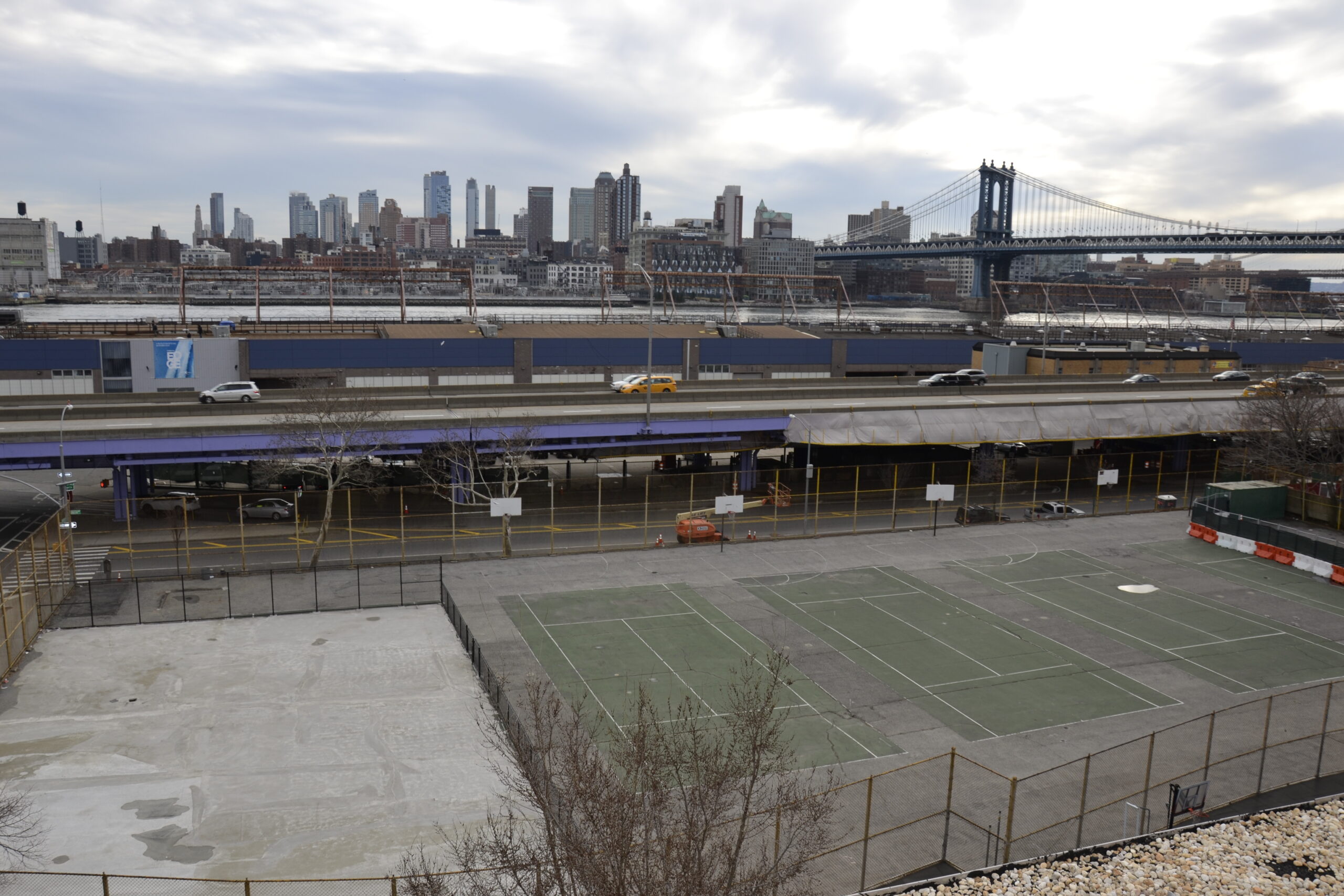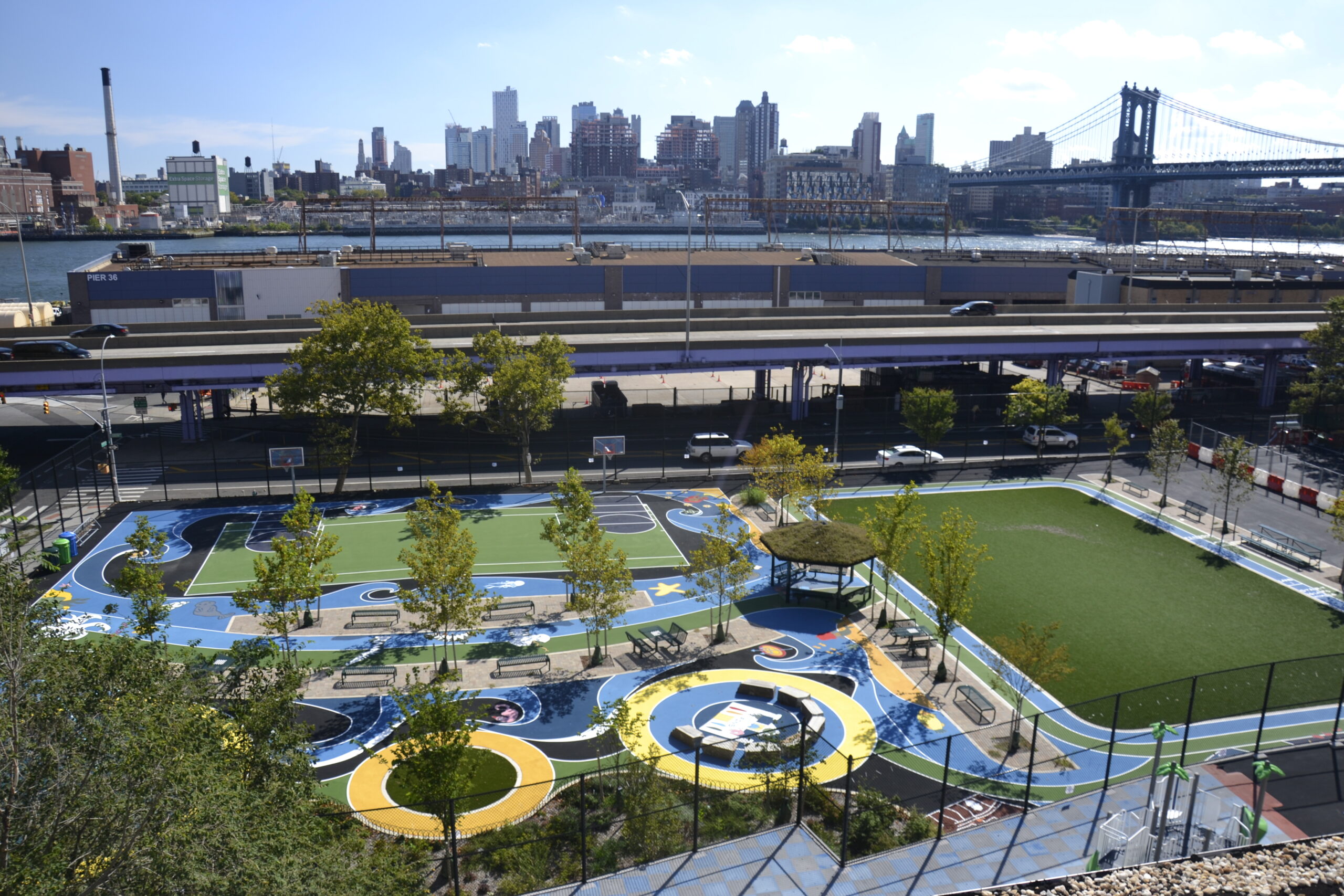Across the country, cities are transforming asphalt schoolyards into spongy, shady community centers. The new playground at PS 184M Shuang Wen School in Manhattan’s Chinatown, for example, has a porous turf field that can capture an estimated 1.3 million gallons of stormwater runoff.

Courtesy of Trust for Public Land
The new schoolyard at Manhattan’s PS 184M Shuang Wen School. The turf field sits atop infiltration basins, reservoirs capable of holding large volumes of stormwater.
This article originally appeared in Nexus Media News and Next City.
The new schoolyard at PS 184M Shuang Wen, a grade school in Manhattan’s Chinatown, features new play equipment, a yoga circle, a stage and basketball and tennis courts.
It also has a porous turf field that can capture an estimated 1.3 million gallons of stormwater runoff, according to New York City’s Department of Environmental Protection (DEP).
The turf field sits atop infiltration basins, reservoirs capable of holding large volumes of stormwater. These basins, paired with a grass-roof gazebo, a student-run rain garden and a slew of new trees, can help New York City better absorb extreme precipitation, which is becoming more frequent and severe with climate change.
“Green infrastructure intercepts stormwater before it can reach a catch basin and allows it to be naturally absorbed into the ground,” explained a representative from DEP. “This creates additional capacity in the sewer system and helps to reduce flooding.”
Urban planners, architects and designers around the world are looking to make cities spongier—using nature-based solutions to better absorb water. In dense cities like New York, where open space is scarce, officials are rethinking a neighborhood mainstay: the school playground.
“Carving out the space, the actual acreage to create a new park can sometimes be cost prohibitive,” said Danielle Denk, director of the Community Schoolyards Initiative at Trust for Public Land (TPL). “But if there’s a schoolyard, that’s land that is often not used to the greatest advantage, and when it can be transformed … it becomes a really smart strategy for park creation.”
Cities across the country have begun to uproot asphalt in favor of lush, green schoolyards—or at least porous turf. TPL has helped transform more than 200 schoolyards—upgrades including adding play spaces and shaded areas—in New York City over the last 30 years with financial support from various city agencies and nonprofits.
The Berkeley, California-based non-profit Green Schoolyards America has been collaborating with schools on similar projects around the globe for over a decade. And last year, Sen. Martin Heinrich (D-NM) introduced the Living Schoolyards Act, a bill that would direct federal resources toward greening school grounds. Several states, including California, Colorado and Maryland, have introduced similar legislation or guidelines.
According to TPL, most of the 90,000 public schoolyards—spanning some two million acres— nationwide are covered in asphalt, a combination of petroleum products that creates runoff when it rains and bakes in the sun.
Concrete and asphalt contribute to urban heat islands, increasing average daytime temperatures by as much as seven degrees in hot weather. Green plots of land in cities do the opposite, reducing surrounding temperatures by up to seven degrees. That can mean the difference between life and death during heat waves—which are increasing in severity and frequency as the planet heats up.
Shuang Wen Public School was a perfect candidate for an update. Located in a floodplain near the East River, its schoolyard was underwater after Superstorm Sandy struck in 2012.


Nine years later, when Hurricane Ida tore through the city, “there was not even a puddle after the tremendous amount of rain that we had,” said Mary Alice Lee, TPL’s New York City Playgrounds Director.
Schoolyards can do more than absorb rainwater and cool neighborhoods. They can also help close the park equity gap nationwide: One hundred million Americans, including 28 million kids, do not live within a 10-minute walk from a park or green space. Communities of color and low-income neighborhoods have even less access to green spaces.
“Schoolyards are an important way to create access to a park,” said Denk. “When they’re open to the community after hours, they can serve so many needs.” Studies show that access to green spaces supports physical and mental health.
Officials appear to be taking note. According to TPL, in 2022, at least 73 of the nation’s 100 largest cities opened schoolyards after hours to the general public, up from just 44 cities in 2018.
Schoolyard improvements are good for students, too.
Studies have linked vegetation in schoolyards to better school-wide academic performance, even after controlling for significant confounding factors like student poverty and minority status. Researchers suggest these improvements in academic achievement may be thanks to green schoolyards’ ability to decrease stress and mental fatigue, increase physical activity, and foster more creative play during recess.
Shuang Wen principal Jeremy Kabinoff said the new playground has allowed administrators to create clubs and host events that would not have been possible before: new tennis and track programs, a soccer league and an outdoor Halloween festival that drew more than 1,000 attendees last year.
When COVID-19 restrictions forced classroom closures, Shuang Wen was able to move classroom learning and other events outside into a still-comfortable learning environment. Kabinoff said the new facilities, including the stage, “gave students the opportunity to experience an authentic graduation experience as well, especially since COVID-19 eliminated many in-person events.”
Shuang Wen students helped design the new schoolyard through discussions, surveys and votes. Denk from TPL, who has worked with dozens of schools to upgrade yards, said students get just as excited about green infrastructure as new playground equipment. She fondly remembers an example from a group of 4th-grade students in Philadelphia.
“We learned all about water quality issues, flooding in the city, combined sewer overflows, and how the city is working to address it and how it’s a big challenge,” she says. “The students came back feeling very empowered to work on a solution in their schoolyard.”
When the time came for students to decide between expanding their playground or building a rain garden to help manage stormwater, the students chose the rain garden. “That is exciting to me,” says Denk. “When students are given the chance to do the right thing for their environment and their community, they will choose that, and that motivation carries forward in terms of how they see themselves as environmental actors and in relation to climate change.”
This article was co-published with Next City as part of Nexus Media News‘ Fairer & Greener series. Nexus Media News is an editorially independent, nonprofit news service covering climate change. Follow us @NexusMediaNews.









One thought on “An Overlooked Climate Solution? Greener Playgrounds”
Terrific initiative! I feel sorry for the young people, growing up in a world faced with climate crisis and biodiversity crisis. Let’s trust them to come up with solutions of their own!